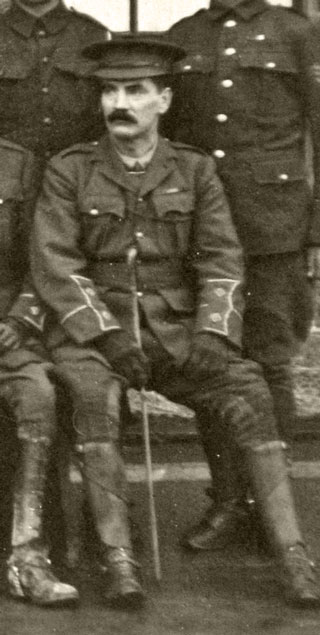Lieutenant Thomas Patrick Dunbar Seymour
Thomas Patrick Dunbar Seymour was born on 4 October 1865 at Ballymore Castle, Laurencetown, County Galway, the first son and one of at least seven children of gentleman Walter Seymour Esq and his wife Belinda Jane (née Gordon). He was educated at Foyle College and Trinity College.
Seymour served in Methuen’s Horse in the Bechuanaland Expedition (1884-85), and in the Second Matabele Rising (1896-97). On 8 January 1900 at Leicester he enlisted in the 4th Battalion, 7th Company, Imperial Yeomanry (No.2161), serving in South Africa in the Boer War from 7 February 1900 to 9 June 1901. On 15 June he was discharged, his conduct and character recorded as 'very good'.
At the time of the 1911 Census he was living at Ballymore Castle with three of his sisters, a brother-in-law, and a niece.
Seymour applied for a commission in the 6th (Inniskilling) Dragoons on 4 November 1914. (He had also applied to the South Irish Horse). He was soon after appointed lieutenant, with seniority from 5 November, and posted to the newly-formed 6th (Inniskilling) Dragoons Service Squadron. He was 49 years old at the time.
On 5 October he embarked for France with his squadron, which was then serving as divisional cavalry to the 36th (Ulster) Division. The squadron war diary mentions him just once over the following period:
9 December 1915: "Famechon. 9.30 Mounted Parade under Lt. Seymour."
In June 1916 the Inniskilling squadron joined with C and F Squadrons of the North Irish Horse to form the 2nd North Irish Horse Regiment, serving as corps cavalry to X Corps. The regimental diary entry for 5 July 1916 describes how a party under Lieutenant Seymour came under heavy artillery fire during the Battle of the Somme:
Orders were received from A.P.M. 36th Division at 9 am for the two troops dismounted to report to Capt O'Neill at Lancashire Dump for salvage duty. They carried out this duty bringing in equipment, rifles etc till 1 pm. The men had dinner and were just turning out again when Lieut Seymour received orders from 36th Division to return to Regtl Head Quarters. The men had just started to saddle up when a heavy bombardment of both high explosive, shrapnel & machine guns was concentrated on the Wood. The intensity of the fire necessitated Lt Seymour giving orders for the men to take shelter in some old dugouts & trenches close by. The bombardment lasted for 3/4 of an hour & then slackened but did not entirely stop. Up to now one horse was killed & four wounded. The men were then ordered to saddle up & lead their horses thro' Wood out on to the road and were waiting for the others to join up when the bombardment opened much heavier than previously especially on that part of the road where the men were waiting. Lt Seymour moved off up the road leaving 2/Lt Matthews & Sergt McIlvoy to round up the stragglers in the wood, as by this time horses were very restive and almost unmanagable. Lt Seymour with his party had reached about 1 mile along the road & turned down a lane leaving the horses in charge of Sergt Quinn. Almost immediately a heavy fire was brought to bear on the horses and Sergt Quinn was wounded. The horses stampeded in every direction, some back to Aveluy Wood. Eventually Lt Seymour was able to round up most of this party & got to Senlis. Lieut Matthews & Sergt McIlroy remained behind. Our losses numbered 16 horses killed or wounded and 2 missing. 2/Lt Matthews was wounded severely in the knee from high explosive and Pte Downes, Nicholl, Gourley wounded (hosp) and Ptes Buchanan, 195 Campbell, Totton, 105 Craig, Cpl Dickson, 209 Robinson slightly wounded (duty).
Over the following year he twice served as acting adjutant of the regiment in the absence of Captain Foster.
In September 1917 the 2nd NIH Regiment was disbanded, with most officers and men transferred to the 9th (Service) Battalion, Royal Irish Fusiliers. Seymour although initially transferred to the battalion, did not join it, having faced a medical board at Le Havre on 2 September. The board found:
He is 51 years of age but of good physique and with the exception of a little emphysema presents no sign of disease. He has already done two winters at the front and is extremely desirous of returning there. At his own earnest request the Board is prepared to consider him fit for general service.
Seymour was transferred to the Royal Army Service Corps from 31 December 1917. He was posted to the 36th Divisional Train, No.253 Company, joining it in the field in France on 6 February 1918. On 14 May he returned to England, serving at RASC depots in Blackheath and Bradford until the end of the war.
He relinquished his commission on 29 January 1919.
After the war Seymour returned to his family home at Ballymore Castle. On 2 April 1921 he married Florence Anne Fetherstonhaugh Thompson in Christ Church, Dublin. He died at Ballymore on 12 March 1946.
This image, part of a group photo of officers and NCOs of the squadron, appeared in the Belfast Evening Telegraph on 28 January 1915. The full image can be seen here.
This page last updated 19 October 2023.

